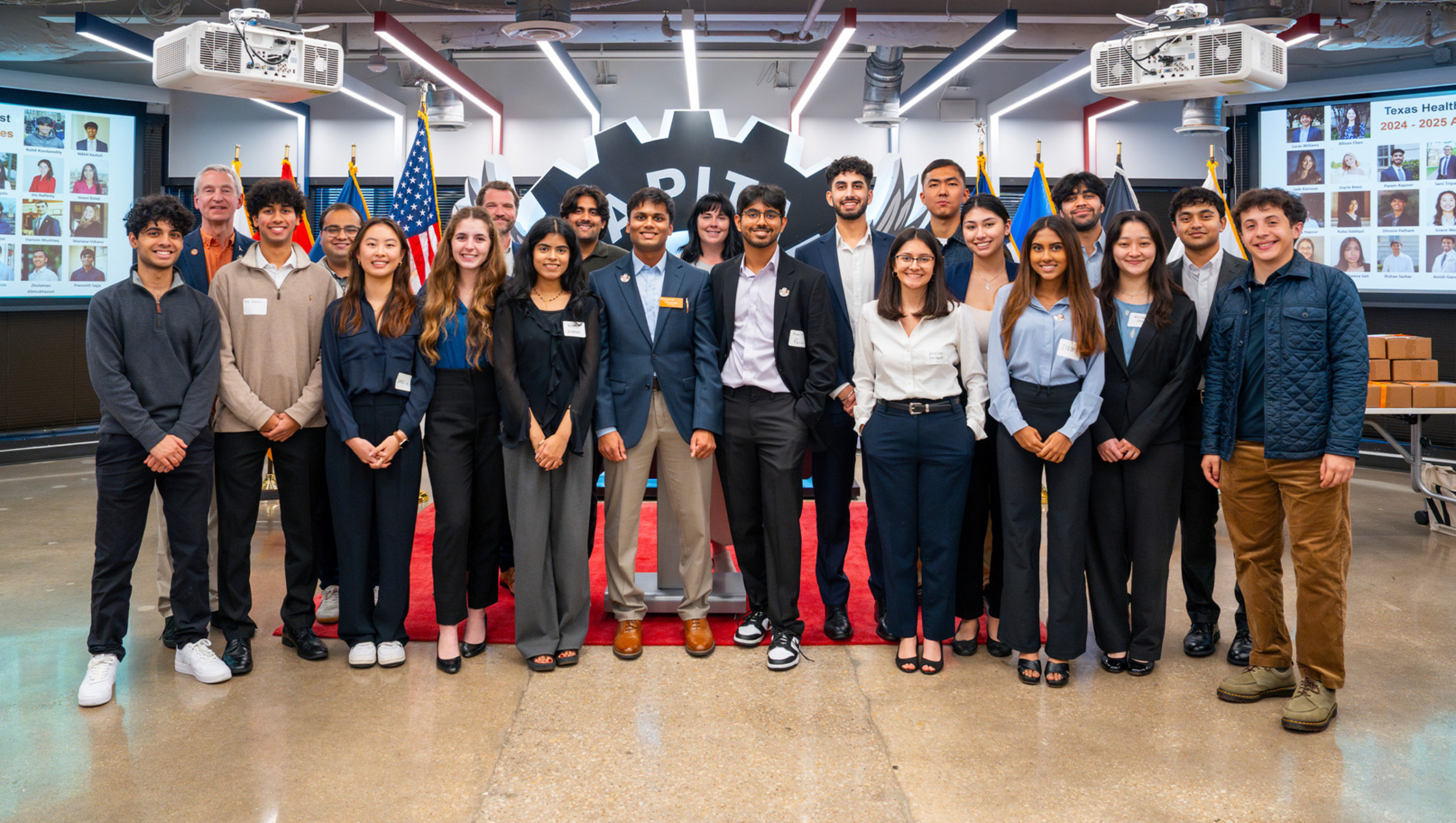This blog is authored by Iris Rafferty, a sophmore premed biomedical engineering student within the Cockrell School of Engineering.
Rafferty’s interests are in translating biotech innovations into real-world solutions, medical devices that intersect clinical needs and implementation, and bioastronautics and aerospace medicine innovations that can support human life in extreme enviorements.
My journey with Texas Health Catalyst at Dell Medical School began when I attended the inaugural Roundup and Rodeo event last July. I’ll never forget the energy in the room. Startups pitched groundbreaking technologies, professionals asked intense questions, and everyone had a shared desire to improve health care. I immediately knew that this is something that I wanted to be a part of.

Iris Rafferty (front row, fourth from the left) stands alongside Texas Health Catalyst associates at the Roundup and Rodeo event held on Jan. 29, 2025.
Following the Roundup and Rodeo event, I applied to Texas Health Catalyst’s associate program, which became my first experience with health care technology commercialization.
The program’s bootcamp sessions equipped me with the knowledge I needed to effectively support Texas Health Catalyst’s active project teams. For six weeks, we explored market landscapes, regulatory pathways, intellectual property strategy and even funding mechanisms like grants and venture capital. It was a crash course in translational science, helping me understand how ideas move from bench to business to bedside.
Each session was led by professionals with expertise in areas like regulatory affairs, intellectual property, venture funding and market strategy, giving us real-world perspectives on the innovation process and fostering meaningful collaboration between students, faculty, clinicians and industry leaders. I was able to use what I learned from the bootcamp to start an initial review of the teams to help select the finalists, assessing in three areas: clinical/scientific, development, and commercialization and commercial viability.
A Front-Row Seat to Innovation
The most interesting part of my experience was the external review meeting, where Texas Health Catalyst brought together leaders from across industry, academia and medicine to evaluate the submitted projects. Sitting in on those conversations was like getting a front-row seat to the future of health care. I found it unique that several projects stemmed from an AbbVie national health care challenge, which promoted industry-aligned solutions to specific health care issues.
I’ll never forget the review of one project in particular: “A Methodologic Approach to the Machine Learning Estimation of Audio Recordings from a Smartphone — Detection of Fetal Movements.” The room was split, and some questioned its viability.
“I don’t see how this could be successfully commercialized. What’s the business model here?” said one reviewer.
“I wish I had something like this during my pregnancy,” said another.
This discussion made it clear to me just how diverse and thoughtful the expert perspectives in the room were, and how critical that diversity is when evaluating early-stage innovations.
That meeting made it easy to choose my top project for the next phase. The fetal detection movement app amazed me, and I couldn’t stop thinking about all the ways it could be developed and brought to market.
Learning How To Assess Market Viability
In December, we transitioned to the consulting phase, where I was paired with my top choice team led by Dr. Kenneth J. Moise and Dr. Kelly Gaither, with expert guidance from mentors Amy Altman and Keli Hawthorne. I also had the chance to work alongside fellow associate Zholaman Aitmukhamet.
This was where everything I learned from the bootcamps really clicked. I applied the market research frameworks we’d learned to focus on our path to market. We assessed the competitive landscape, discussed whether the product would be direct-to-consumer or physician-prescribed and examined IP considerations. After assessing the market, I found there was strong potential for the product. There were many fetal movement apps that were already popular, but they only functioned as manual counters. This showed a real need for an accurate fetal movement detection app. We discussed our findings during weekly associate huddles, where we also heard updates on other inspiring projects across the program.
At the end of January, the Roundup and Rodeo pitch competition took place, and I had the opportunity to introduce Dr. Moise, who presented our team’s findings. Our project ultimately won their Pioneer Award recognizing our clear and compelling articulation of a core problem statement.
A Valuable Learning Experience
Attending my second Roundup and Rodeo, I felt like I was beginning to build a real network within the community. I saw familiar faces from previous events and had the chance to reconnect, hear about exciting projects and learn more about what folks were passionate about.
I’ve been fortunate to continue working with the fetal movement detection team beyond the program, helping push the project even closer to real-world application. Texas Health Catalyst not only gave me the tools to evaluate innovation, but it also gave me a seat at the table. And I know this is just the beginning.
Whether you’re a University of Texas student, faculty member, clinician or supporter of health innovation, Texas Health Catalyst offers a space where your ideas and contributions can drive real impact. If this story sparked your interest, we encourage you to get involved and help shape the future of health care.